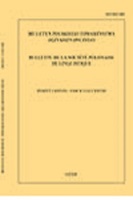Komutacja (stosunek paradygmatyczny) i kookurencja (stosunek syntagmatyczny) w świetle algebry Boole’a
Commutation (paradigmatic relation) and co-occurrence (syntagmatic relation) in the light of Boole’s algebra
Author(s): KAZIMIERZ A. SROKASubject(s): Syntax, Descriptive linguistics, Methodology and research technology
Published by: Polskie Towarzystwo Językoznawcze
Keywords: relation of location; commutation (paradigmatic relation); co-occurrence (syntagmatic relation); values (particular relations) of commutation and co-occurrence; identity; exclusion; inclusion; interse
Summary/Abstract: The paper discusses commutation and co-occurrence, which are relations of location, i.e. relations between textual entities, A and B, with regard to their occurrence in a given environment. Commutation (paradigmatic relation) is the relation of non-simultaneous (substitutional) occurrence, while co-occurrence (syntagmatic relation) is the relation of simultaneous occurrence. With regard to the internal variation of each of these relations, when treated as a category, type, or class, one can speak of their “values” (as is done by the present author) or “relations” as specimens. The aim of the paper is (1) to give, on the basis of selected studies, an overview of the theory of commutation and co-occurrence and (2) to propose the description of the values of these relations in the shape of operations of Boole’s algebra. P a r t 1 of the paper presents the essential points of Leon Zawadowski’s approach (LTJ, 1966: 314‒361), who speaks of syntagmatic and commutational “connections” (instead of relations) and focuses on the nature of this distinction as well as on the characteristics of particular “connections” (i.e. relations, and, in our terminology, values) within each of the two types. Zawadowski’s treatment of the problem is an important stage in the development of the theory of commutation and co-occurrence. P a r t 2 gives an outline of the present author’s earlier contribution concerning the problem discussed. It includes (1) the use of the values of commutation (under the name of distributional relations) for the description of syntactic phenomena (presented in his PhD thesis English Phrasal Verbs, 1965, published later as The Syntax of English Phrasal Verbs, 1972) and (2) in relation to Zawadowski’s approach, a revised and enriched treatment of commutation and co-occurrence, including a discussion of their values (see Chapter 2 of The Dynamics of Language, 1976: 9, 21‒37). In DL, the author establishes and describes 16 values (one of them empty), which are the same for commutation and co-occurrence, and juxtaposes them in tables. P a r t 3 contains a new proposal, namely a description of the values of commutation and co-occurrence in the schema of the Boolean function f (x, y) of two variables by applying this function in the shape of the sums of minimal polynomials, e.g., in the case of the symmetric exclusion of A and B with complementation, the function f = (A ∩ ~ B) U (~A ∩ B), where “∩” = logical product, “U” = logical sum, and “~” = negation.
Journal: Biuletyn Polskiego Towarzystwa Językoznawczego
- Issue Year: LXXVIII/2022
- Issue No: 78
- Page Range: 205-220
- Page Count: 16
- Language: Polish

